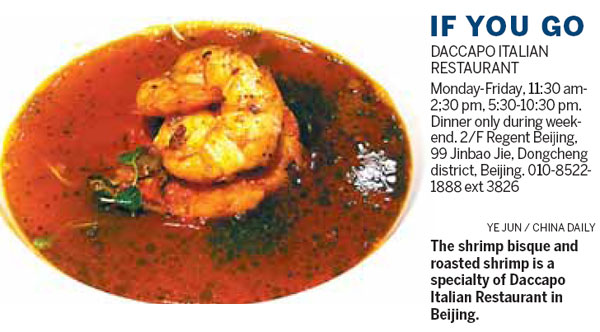Haute Italian with color

To stand head and shoulders above the many good Italian restaurants in Beijing, the food must be truly exceptional - and memorable. During a recent visit to Daccapo, the Italian restaurant at the Regent Beijing, I went away with clear memories of two dishes.
One was the shrimp bisque and roasted shrimp, which more than matched the best seafood I had tried in Italy. It had that fresh sea taste that makes you go "wow" and think, "that's how seafood should be".
The other dish was a Boston lobster salad, with orange jelly and edible flowers. The tender lobster is presented on a canvas of herbs and vegetables, artistically placed on a bed of orange gelatin.
I had been to Daccapo before its current relocation, but no dish had left such deep impressions.
The restaurant recently moved to make space for Morton's, the American steakhouse that is scheduled to open at the hotel in mid-October.
Daccapo's chef Mario Cittadini says his restaurant business is better than ever.
The restaurant is now cozier, with an ambience more conducive to private and fine dining. There is comfortable wood and leather furniture, oil paintings and gauze curtains. In comparison, it was more business like before its move.
Cittadini says the restaurant has changed what it offers to guests. For one, pizzas are now off the menu.
"Everybody makes pizza," he says. "It's only a small part of Italian food, like rice in Chinese cuisine."
Looking at the menu and what it offers, it's hard to miss the pizzas.
"We have brought in more typical and varied Italian food, and we are still keeping the signature dishes," says Cittadini, who is also the executive sous chef of the hotel.
There are now Italian cold cuts, such as salami, mortadella, and cuppa, and the chef has added porchetta, the traditional suckling pig roll with sausage stuffing, and osso buco with saffron risotto and bone marrow. Pasta is handmade.
The shrimp bisque and roast shrimp is also a new dish and the ingredients come from China. Pan-fried wild sea bass is paired beautifully with confit fennel, and beef cheek is slow braised for 12 hours to offer the softest texture.
"Sixty percent of the flavor comes from the ingredient, and 40 percent is from the chef," Cittadini says. "The restaurant only orders the best seafood we can find.
"We buy all the best we can find in the market, then play with it in the style of modern Italian cuisine, but with traditional flavor. You have to understand the ingredient, how to play with it, and you have to study."
He says he goes back to Italy to keep himself updated of new styles in Italian cuisine as those in China are different because the product and the market are different. He admits he tries to keep the flavor of food easy for local patrons to understand.
"Sometimes we cannot make it 100 percent authentic Italian because the Asian palate might not like it," he says. For example, Chinese diners may not like very strong cheese.
The chef has been trying Chinese food because he says the experience helps him understand what local diners appreciate.
"For example, the Chinese like their noodles soft, and the same applies to rice," the chef notes. But, there are some universal truths.
"Food is beautiful by itself. I just make sure it is cooked well."
















